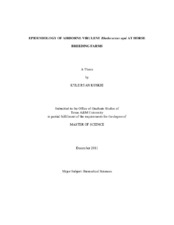| dc.contributor.advisor | Cohen, Noah D. | |
| dc.creator | Kuskie, Kyle Ryan | |
| dc.date.accessioned | 2012-02-14T22:19:25Z | |
| dc.date.accessioned | 2012-02-16T16:19:59Z | |
| dc.date.available | 2012-02-14T22:19:25Z | |
| dc.date.available | 2012-02-16T16:19:59Z | |
| dc.date.created | 2011-12 | |
| dc.date.issued | 2012-02-14 | |
| dc.date.submitted | December 2011 | |
| dc.identifier.uri | https://hdl.handle.net/1969.1/ETD-TAMU-2011-12-10270 | |
| dc.description.abstract | Rhodococcus equi causes severe pneumonia, resulting in disease and sometimes death of foals. Infection is thought to occur by inhalation of dust contaminated with virulent R equi. A recent study of 3 horse breeding farms in Ireland found airborne concentrations of virulent R equi to be significantly higher in stables than in paddocks. More importantly, another study from Australia established an association of airborne concentrations of virulent R equi with the prevalence of R equi pneumonia at 28 farms. The extent to which these associations extend to other farms in different parts of the world is not known.
Two farms in central Kentucky with recurrent R equi pneumonia in foals were studied from February through July 2008. Air samples were collected and environmental factors were measured hourly for a 24-hour period each month from stalls and paddocks used to house mares and their foals at each farm. In 2009, samples were collected from 47 foals from stalls at a single horse-breeding farm in central Kentucky on days 1-2, days 7-9, and days 14-16 of life. Concentrations of airborne virulent R equi were determined via a modified colony immunoblot technique.
Airborne concentrations of virulent R equi were significantly higher (P = 0.016) from 6:00 A.M. through 11:59 P.M. than for the period from midnight through 5:59 A.M. Presence of the mare and foal at the time of sampling was significantly (P < 0.001) associated with increased airborne concentrations of virulent R equi in stalls. The presence of virulent R equi in stalls was significantly (P = 0.045) more likely at 7 days of age for foals subsequently found to be affected by rhodococcal pneumonia.
These findings suggest that recovery of airborne virulent R equi is less likely between 12:00 A.M. and 5:59 A.M., relative to other times, that airborne concentrations of virulent R equi are significantly increased when horses are present at the site for collection of air samples, and that environments containing airborne virulent R equi during the first week of life may influence the risk of subsequent disease for a foal. | en |
| dc.format.mimetype | application/pdf | |
| dc.language.iso | en_US | |
| dc.subject | Rhodococcus equi | en |
| dc.subject | Epidemiology-equine diseases | en |
| dc.subject | Airborne | en |
| dc.title | Epidemiology of Airborne Virulent Rhodococcus equi at Horse Breeding Farms | en |
| dc.type | Thesis | en |
| thesis.degree.department | Veterinary Large Animal Clinical Sciences | en |
| thesis.degree.discipline | Biomedical Sciences | en |
| thesis.degree.grantor | Texas A&M University | en |
| thesis.degree.name | Master of Science | en |
| thesis.degree.level | Masters | en |
| dc.contributor.committeeMember | Chaffin, Morgan K. | |
| dc.contributor.committeeMember | Lawhon, Sara | |
| dc.type.genre | thesis | en |
| dc.type.material | text | en |


